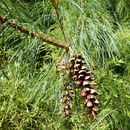More info for the terms:
competition,
fern,
hardwood,
seed,
tree,
xericEastern white pine occurs on a variety of sites along the full moisture
gradient from wet bogs and moist streambottoms to xeric sand plains and
rocky ridges [
7,
67]. In Maine and New Brunswick, eastern white pine
occurs in well0drained, raised bogs [
8]; in Michigan, it occurs on sand
dunes [
42]. In the southern Appalachian Mountains and in Pennsylvania,
pure stands mainly occur on northerly aspects, in coves, and on
streambottoms [
11]. Eastern white pine is common on the east shore of
lakes where blowdowns create openings for regeneration [
28].
In New England, eastern white pine usually occurs between sea level and
2,000 feet (610 m) in elevation; on Catamount Mountain in the Adirondack
Mountains of New York, it occurs up to 3,168 feet (966 m). In the
southern Appalachian Mountains, it occurs between 1,200 and 3,500 feet
(370-1,070 m) [
11,
28]
Eastern white pine grows on nearly all soil types within its range. It
is most competitive on fairly infertile sandy soils, such as
well-drained outwash soils. On clay or poorly drained soils, eastern
white pine occurs only as individuals or in small groups. It grows on
fine sandy loams and silty loams on disturbed sites if there is little
hardwood competition [
68].
Eastern white pine is the characteristic old-field species in New
England. Nearly pure stands develop on old fields where seed is ample
and sod is intact [
53]. In the Hudson River valley, eastern white pine
dominates the finer textured, less rocky old-field sites, whereas oak
communities dominated the coarser textured, rockier sites [
15].
Tree associates of eastern white pine not mentioned in Distribution and
Occurrence include sweet birch (Betula lenta), bigtooth aspen (Populus
grandidentata), quaking aspen (P. tremuloides), black cherry (Prunus
serotina), and black oak (Quercus velutina) [
11].
Understory species are scarce in pure stands of eastern white pine. On
dry sites, associates include blueberries (Vaccinium spp.), wintergreen
(Gaultheria procumbens), dwarf bush-honeysuckle (Diervilla lonicera),
sweetfern (Comptonia peregrina), bracken fern (Pteridium aquilinum),
clubmosses (Lycopodium spp,), and broomsedge (Andropogon virginicus).
On moist, rich sites associates include wood sorrel (Oxalis spp.),
partridgeberry (Mitchella repens), wild sarsaparilla (Aralia
nudicaulis), jack-in-the-pulpit (Arisaema triphyllum), and hay-scented
fern (Dennstaedtia punctilobula). Other associates include bigleaf
aster (Aster macrophyllus), Canada mayflower (Maianthemum canadense),
and bunchberry (Cornus canadensis) [
11,
41,
25].

